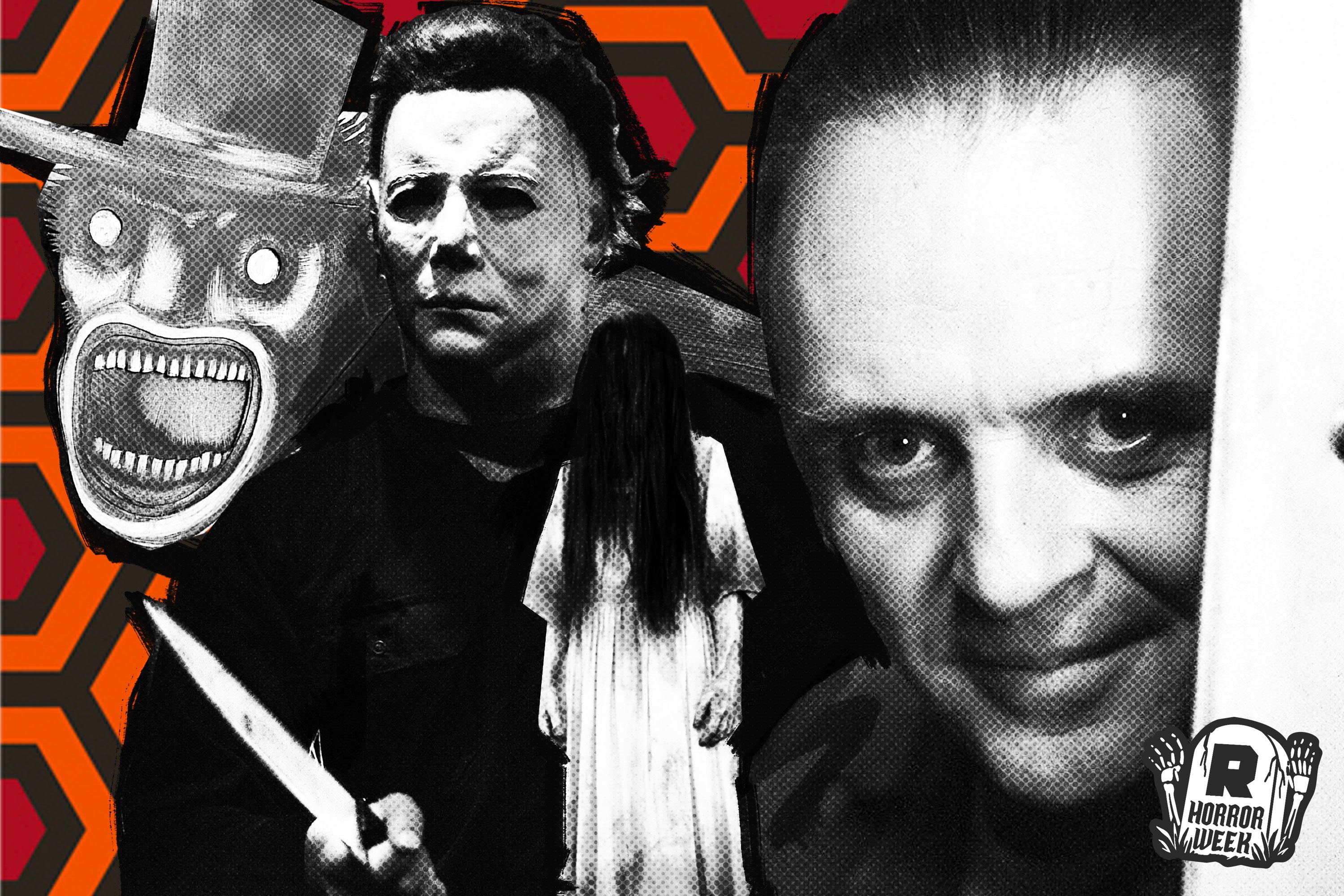
It wouldn’t be Horror Week without honoring the movie monsters and villains who have haunted our dreams for decades. Below, Ringer staffers make their case for who is the best horror movie monster. How brave of them.
The Overlook Hotel, The Shining
Kate Knibbs: There have been flashier, more obvious monsters than The Shining’s Overlook Hotel. Pennywise looks like an evil clown and prances around murdering children, those giant ear spiders from A Quiet Place make me want to hide in a closet, and the Babadook is the most fabulous and menacing thing I’ve ever looked at with my own eyes. The Overlook Hotel, by comparison, is a classy, roomy establishment enhanced by the natural beauty of the mountains. It provides only glimpses of the sinister—a few dead twins here, a little elevator full of blood there—until it’s too late. And it makes you or your loved one insane, and then you or your loved one starts murdering everybody. There have been lots of chilling portrayals of evil in film, but the thing that makes the Overlook Hotel so scary is that it’s the home for evil, the place where it bubbles up and renews itself. (The town of Derry in Stephen King’s It also fits this bill, but I think the dramatic, secluded setting of the Overlook pushes it ahead in terms of awesome fearfulness.) You can run away from a person, but it’s much harder to escape an isolated location, and so the Overlook is the type of place that just keeps consuming souls and then waiting for the next to arrive. The scariest villains aren’t the kind who chase. They’re the kind who wait.
Samara, The Ring
Claire McNear: Samara’s claims to the all-time terror throne are thus. (1) She’s a child, the creepiest kind of person. (2) She’s basically unstoppable; her weapon of choice is, essentially, fear, and no amount of sunlight or kitchen knives or Manly Men About the House (the usual horror defenses) will stop that. (3) Most importantly, She tells you exactly what she’s going to do. Seven days, suckers! Now it’s six! In five days, you will be deader than dead! Et cetera. Much like a vacation, the most meaningful part of grisly death is the anticipation. (Also, baddies that are so scary that their mere striding—OK, crawling—into a room gets the job done are in a league of their own.)
The Babadook, The Babadook
Alison Herman: OK, sure, the “twist” of the Babadook is that the monster isn’t so much the Babadook as the taboo anger and resentment directed by a widowed single mother against her own child. But in the hour or so that precedes that psychological reveal, first-time director Jennifer Kent made a fictional Australian pop-up book character who dressed like Diane Keaton into the stuff of our collective nightmares. Now, we accept the domesticated spirit as the queer icon it truly is; then, that rattling BA-BA-DOOOOOOOOOK had me cowering in the far corners of my bedroom in broad daylight. Maybe it’s because the monster is basically a greatest-hits collection of iconic bogeymen: children’s entertainment, check. Cursed objects, check. Weird grabby fingers like the guy from Pan’s Labyrinth, check. Recency bias be damned; Kent took notes from the best.
The Alien, Alien
Ben Lindbergh: I’m immune to most horror movie villains because I refuse to see most horror movies. I will watch almost anything that says “sci-fi,” though, so in spite of my wishes I was exposed to the most horrific creature of all: the insectile Alien from Alien, known as “Xenomorph XX121” to its friends. Just kidding: It doesn’t have friends. It has only hosts and victims.
The Alien is as unempathetic as Leatherface and can kill the crew of a spaceship in the time it takes Hannibal Lecter to finish sipping his Chianti. The phallic, eyeless H.R. Giger creation has three life phases, each as disturbing and deadly as the last: the facehugger, the chest-burster, and the nigh-unkillable full-grown form, which even when wounded sprays acidic blood as a final fuck-you. Many movie monsters are scarier off screen than they are in close-up, but the Alien is equally terrifying as an unseen stalker and an immediate, in-your-face (literally) adversary. The Alien is an ultra-adaptive triumph of evolution, which may make it more unnerving than any supernatural being whose existence seems far-fetched as long as the lights are on. Natural selection is the most formidable monster of all, and it’s not just movie magic.
Hannibal Lecter, The Silence of the Lambs
Megan Schuster: Creepy, cobbled-together monsters like the creature from Frankenstein, the Babadook, and Michael Myers are frightening. So, too, are supernatural beings, elements of religious possession, and any lifeform that originates in outer space. But what makes a horror movie antagonist truly terrifying—and therefore truly great—is its proximity to our society and everyday lives. That’s why Hannibal Lecter from The Silence of the Lambs is the best horror movie villain.
Hannibal Lecter is villainous on so many levels. There’s the first, most obvious one: He’s a cannibal. The second is his psychological makeup; he’s always calmly collected, and wickedly smart, but he possesses no conscience or sense of empathy. He manipulates the people around him for sport and has no regard for the damage he causes. Finally, and perhaps most terrifyingly, he’s realistic. He’s not some strange alien from another planet that you can distance yourself from after the movie ends, or a phantom entity that you can dismiss as fiction. He seems as if he could really be out there somewhere, working as a forensic psychiatrist and lying in wait. That is the most haunting villainy of all.
The It, It Follows
Andrew Gruttadaro: All of the horror movie monsters mentioned by my colleagues are perfectly adequate choices, but here’s why they’re all wrong: Those monsters are all knowable. They all have distinguishable characteristics, names, motivations. On the other hand, the “it” that stalks Jay (Maika Monroe) in It Follows has none of these things. We do not know what it looks like, only that it takes the form of bone-chilling elderly women and extremely terrifying giants. We do not know where it came from. We do not know what it wants. We do not know if it can ever truly be stopped. All we know is that if you have sex with the wrong person, it will follow you until it has erased you.
The simplicity of this villain, the sheer nothingness that typifies it, is what makes it the only horror movie monster that keeps me awake.
The Devil, Many Films
Michael Baumann: Seldom do we see the devil in a horror movie, though there are exceptions (call me, Gabriel Byrne in End of Days). But fear isn’t about what you can see. As frightful as a vicious monster or an inbred giant with a chainsaw can be, those are corporeal fiends that can be identified and conquered. “The great Satan hisself is red and scaly with a bifurcated tail, and he carries a hayfork,” says George Clooney’s Everett in O Brother, Where Art Thou? and sometimes he’s right about that. But the devil can change shape at will, and his near-omnipotence is far scarier than any slasher’s meat cleaver.
But more than anything else, Satan is the most common horror movie villain that tens of millions of Americans, if not hundreds of millions, believe with their whole hearts to be real. A friend of mine, who was raised a devout Catholic, just up and walked out of The Exorcism of Emily Rose because he couldn’t handle it. It’s one thing to scream and chuck your popcorn in the air when Leatherface pops out from behind a corner, but you don’t go home and worry about Leatherface coming after you in real life. Not so with the devil, whose presence permeates every corner of society. Nothing is scarier than that.
The Thing, The Thing
Miles Surrey: Some of the scariest movie monsters ever have been shape-shifters. The creature of It manifests itself as one of your primal fears (often a clown, because of course); the “it” of It Follows perpetually pursues its victim at a terrifying, glacial pace. But while these monsters take several forms, they’re easy to distinguish from regular humans. That’s why the alien creature of The Thing is so terrifying; it’s all about near-immaculate immersion.
John Carpenter’s ’80s classic has a simple premise: A shape-shifting alien has infiltrated a research group in Antarctica and can take the form of anyone. That it can embody someone so effortlessly is the stuff of nightmares; imagine if you suddenly couldn’t trust the coworker you’d known for months because they might devour you. Imagine if their chest cavity became a giant mouth on an operating table.
The Thing ends with two surviving characters stranded, while the identity of the creature, if it’s still alive, is left ambiguous. Whether the thing is one of the survivors—and which one—has been debated for decades. That there isn’t a definitive answer is terrifying in and of itself.
Michael Myers, Halloween
Shea Serrano: This is simple: Michael Myers is a scary movie monster for a lot of reasons. His mask is scary. His weapon of choice of scary. The fact he never talks is scary. His size is scary. His determination is scary. I can go on and and on and on. But the reason Michael Myers is THE SCARIEST movie monster is because he’s the most plausible.
Everybody else—and when I say “everybody else” I’m referring to the upper echelon of movie monsters that always get brought up whenever these types of conversations happen—had an origin story that required you to believe in, for lack of a better term, “magic” of some sort. Jason Voorhees, for example, was the adult demon version of a kid who drowned in a lake and came back to kill camp counselors. Freddy Krueger was a living nightmare who hunted the children of the people who tossed him into a furnace. Pennywise was the manifestation of fear. So on and so forth and such and such.
Michael Myers wasn’t any of that. He was just a guy who really, really, really wanted to stab a person in their chest or head or back or whatever. You didn’t have to believe in anything beyond evil for him to be effective. Evil is obviously real. Which means that Michael is obviously real.

